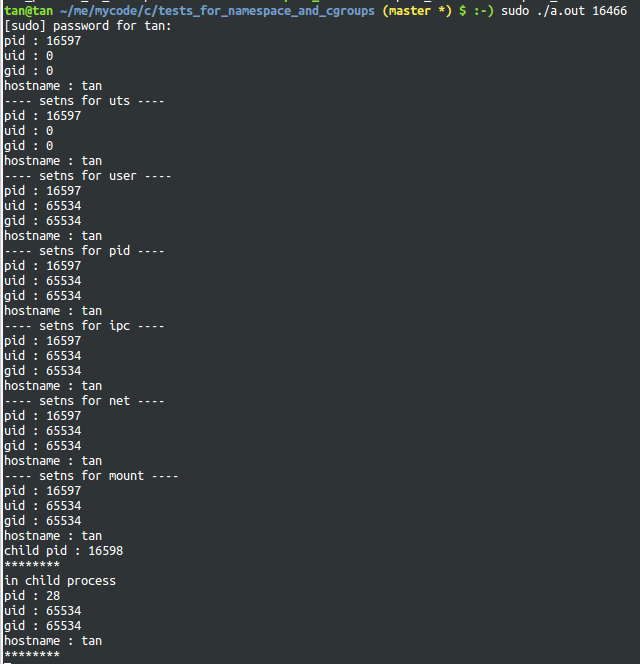簡單玩了下Linux kernel為容器技術提供的基礎設施之一namespace(另一個是cgroups),包括uts/user/pid/mnt/ipc/net六個(3.13.0的內核). 這東西主要用來做資源的隔離,我感覺本質上是全局資源的映射,映射之間獨立了自然隔離了。主要涉及到的東西是:
clone setns unshare /proc/pid/ns, /proc/pid/uid_map, /proc/pid/gid_map等下面是一些簡單的例子,主要測試uts/pid/user/mnt四個namespace的效果,測試代碼主要用到三個進程,一個是clone系統調用執行/bin/bash後的進程,也是生成新的子namespace的初始進程,然後是打開/proc/pid/ns下的namespace鏈接文件,用setns將第二個可執行文件的進程加入/bin/bash的進程的namespace(容器),並讓其fork出一個子進程,測試pid namespace的差異。值得注意的幾個點:
不同版本的內核setns和unshare對namespace的支持不一樣,較老的內核可能只支持ipc/net/uts三個namespace 某個進程創建後其pid namespace就固定了,使用setns和unshare改變後,其本身的pid namespace不會改變,只有fork出的子進程的pid namespace改變 setns將進程加入的新namespace需是此進程的後代namespace 用setns添加mnt namespace應該放在其他namespace之後,否則可能出現無法打開/proc/pid/ns/…的錯誤
// 代碼1: 開一些新的namespace(啟動新容器)
#define _GNU_SOURCE
#include
#include
#include
#include
#include
#include
#define errExit(msg) do { perror(msg); exit(EXIT_FAILURE); \
} while (0)
/* Start function for cloned child */
static int childFunc(void *arg)
{
const char *binary = "/bin/bash";
char *const argv[] = {
"/bin/bash",
NULL
};
char *const envp[] = { NULL };
/* wrappers for execve */
// has const char * as argument list
// execl
// execle => has envp
// execlp => need search PATH
// has char *const arr[] as argument list
// execv
// execvpe => need search PATH and has envp
// execvp => need search PATH
//int ret = execve(binary, argv, envp);
int ret = execv(binary, argv);
if (ret < 0) {
errExit("execve error");
}
return ret;
}
#define STACK_SIZE (1024 * 1024) /* Stack size for cloned child */
int main(int argc, char *argv[])
{
char *stack;
char *stackTop;
pid_t pid;
stack = malloc(STACK_SIZE);
if (stack == NULL)
errExit("malloc");
stackTop = stack + STACK_SIZE; /* Assume stack grows downward */
//pid = clone(childFunc, stackTop, CLONE_NEWUTS | CLONE_NEWNS | CLONE_NEWPID | CLONE_NEWUSER | SIGCHLD, NULL);
pid = clone(childFunc, stackTop, CLONE_NEWUTS | CLONE_NEWNS | CLONE_NEWPID | CLONE_NEWUSER | CLONE_NEWIPC | SIGCHLD, NULL);
//pid = clone(childFunc, stackTop, CLONE_NEWUTS | //CLONE_NEWNS | CLONE_NEWPID | CLONE_NEWUSER | CLONE_NEWIPC //| CLONE_NEWNET | SIGCHLD, NULL);
if (pid == -1)
errExit("clone");
printf("clone() returned %ld\n", (long) pid);
if (waitpid(pid, NULL, 0) == -1)
errExit("waitpid");
printf("child has terminated\n");
exit(EXIT_SUCCESS);
}
// 代碼2: 使用setns加入新進程
#define _GNU_SOURCE // ?
#include
#include
#include
#include
#include
#include
#include
#include
#include
#include
// mainly setns and unshare system calls
/* int setns(int fd, int nstype); */
// 不同版本內核/proc/pid/ns下namespace文件情況
/*
CLONE_NEWCGROUP (since Linux 4.6)
fd must refer to a cgroup namespace.
CLONE_NEWIPC (since Linux 3.0)
fd must refer to an IPC namespace.
CLONE_NEWNET (since Linux 3.0)
fd must refer to a network namespace.
CLONE_NEWNS (since Linux 3.8)
fd must refer to a mount namespace.
CLONE_NEWPID (since Linux 3.8)
fd must refer to a descendant PID namespace.
CLONE_NEWUSER (since Linux 3.8)
fd must refer to a user namespace.
CLONE_NEWUTS (since Linux 3.0)
fd must refer to a UTS namespace.
*/
/* // 特殊的pid namespace
CLONE_NEWPID behaves somewhat differently from the other nstype
values: reassociating the calling thread with a PID namespace changes
only the PID namespace that child processes of the caller will be
created in; it does not change the PID namespace of the caller
itself. Reassociating with a PID namespace is allowed only if the
PID namespace specified by fd is a descendant (child, grandchild,
etc.) of the PID namespace of the caller. For further details on
PID namespaces, see pid_namespaces(7).
*/
/*
int unshare(int flags);
CLONE_FILES | CLONE_FS | CLONE_NEWCGROUP | CLONE_NEWIPC | CLONE_NEWNET
| CLONE_NEWNS | CLONE_NEWPID | CLONE_NEWUSER | CLONE_NEWUTS | CLONE_SYSVSEM
*/
#define MAX_PROCPATH_LEN 1024
#define errorExit(msg) \
do { fprintf(stderr, "%s in file %s in line %d\n", msg, __FILE__, __LINE__);\
exit(EXIT_FAILURE); } while (0)
void printInfo();
int openAndSetns(const char *path);
int main(int argc, char *argv[])
{
if (argc < 2) {
fprintf(stdout, "usage : execname pid(find namespaces of this process)\n");
return 0;
}
printInfo();
fprintf(stdout, "---- setns for uts ----\n");
char uts[MAX_PROCPATH_LEN];
snprintf(uts, MAX_PROCPATH_LEN, "/proc/%s/ns/uts", argv[1]);
openAndSetns(uts);
printInfo();
fprintf(stdout, "---- setns for user ----\n");
char user[MAX_PROCPATH_LEN];
snprintf(user, MAX_PROCPATH_LEN, "/proc/%s/ns/user", argv[1]);
openAndSetns(user);
printInfo();
// 注意pid namespace的不同行為,只有後續創建的子進程進入setns設置
// 的新的pid namespace,本進程不會改變
fprintf(stdout, "---- setns for pid ----\n");
char pidpath[MAX_PROCPATH_LEN];
snprintf(pidpath, MAX_PROCPATH_LEN, "/proc/%s/ns/pid", argv[1]);
openAndSetns(pidpath);
printInfo();
fprintf(stdout, "---- setns for ipc ----\n");
char ipc[MAX_PROCPATH_LEN];
snprintf(ipc, MAX_PROCPATH_LEN, "/proc/%s/ns/ipc", argv[1]);
openAndSetns(ipc);
printInfo();
fprintf(stdout, "---- setns for net ----\n");
char net[MAX_PROCPATH_LEN];
snprintf(net, MAX_PROCPATH_LEN, "/proc/%s/ns/net", argv[1]);
openAndSetns(net);
printInfo();
// 注意mnt namespace需要放在其他後面,避免mnt namespace改變後
// 找不到/proc/pid/ns下的文件
fprintf(stdout, "---- setns for mount ----\n");
char mount[MAX_PROCPATH_LEN];
snprintf(mount, MAX_PROCPATH_LEN, "/proc/%s/ns/mnt", argv[1]);
openAndSetns(mount);
printInfo();
// 測試子進程的pid namespace
int ret = fork();
if (-1 == ret) {
errorExit("failed to fork");
} else if (ret == 0) {
fprintf(stdout, "********\n");
fprintf(stdout, "in child process\n");
printInfo();
fprintf(stdout, "********\n");
for (;;) {
sleep(5);
}
} else {
fprintf(stdout, "child pid : %d\n", ret);
}
for (;;) {
sleep(5);
}
waitpid(ret, NULL, 0);
return 0;
}
void printInfo()
{
pid_t pid;
struct utsname uts;
uid_t uid;
gid_t gid;
// pid namespace
pid = getpid();
// user namespace
uid = getuid();
gid = getgid();
// uts namespace
uname(&uts);
fprintf(stdout, "pid : %d\n", pid);
fprintf(stdout, "uid : %d\n", uid);
fprintf(stdout, "gid : %d\n", gid);
fprintf(stdout, "hostname : %s\n", uts.nodename);
}
int openAndSetns(const char *path)
{
int ret = open(path, O_RDONLY, 0);
if (-1 == ret) {
fprintf(stderr, "%s\n", strerror(errno));
errorExit("failed to open fd");
}
if (-1 == (ret = setns(ret, 0))) {
fprintf(stderr, "%s\n", strerror(errno));
errorExit("failed to setns");
}
return ret;
}
user的效果 : 通過/proc/pid/uid_map和/proc/pid/gid_map設置container外用戶id和容器內用戶id的映射關系(把這放前面是因為後面hostname和mount需要權限…)



uts的效果 : 改變container中的hZ喎?http://www.2cto.com/kf/ware/vc/" target="_blank" class="keylink">vc3RuYW1lsru74dOwz+xjb250YWluZXLN4sPmtcRob3N0bmFtZTxiciAvPg0KPGltZyBhbHQ9"這裡寫圖片描述" src="http://www.2cto.com/uploadfile/Collfiles/20160611/20160611095436693.png" title="\" />

pid和mnt的效果 : container中進程id被重新映射,在container中重新掛載/proc filesystem不會影響容器外的/proc


setns的測試
依次為init進程,container init進程(6個namespace的flag都指定了),新加入container的進程以及其fork出的子進程的namespace情況,可以看到container init進程與init進程的namespace完全不同了,新加入container的進程除了pid與init相同外,其他namespace與container init進程相同,而新加入container的進程fork出的子進程的namespace則與container init進程完全相同

新加入container init進程pid namespace的子進程


程序2輸出
